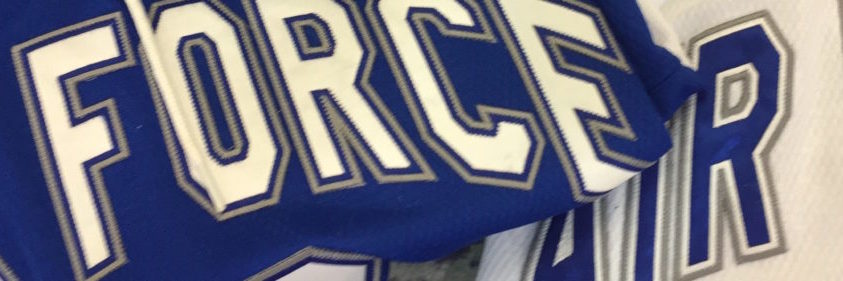The path to success in hockey starts in the middle of the ice – from goal to defense to center.
In college hockey, that strength typically rides shotgun with experience. That is one reason why Air Force’s top-six finish in Atlantic Hockey is so impressive. The sixth-seeded Falcons, who will play at third-seeded Army West Point in this week’s conference quarterfinals, are AHA’s least experienced team in two of those three categories, according to an analysis of late-season lineups by The Flight Path.
“Everyone knew we had a young group,” goaltender Alex Schilling said last week. “For us to rise to the occasion and earn that playoff bye is quite special.”
Breaking it down
Schilling, the team’s lone senior, is a mainstay in net. He’s one of just three seniors who regularly start in goal in AHA. Three more teams, including Army, start sophomores. The other four play juniors.
On defense, the Falcons often have dressed one upperclassman (junior Brandon Koch), three sophomores (Sam Brennan, Luke Robinson and Luke Rowe), and some combination of freshmen (Mitchell Digby with either Drake Usher or Jasper Lester) most of the season. Lately, junior Andrew Kruse, an ace penalty killer and defender, has worked his way into a top-six spot. So at max there are two upperclassmen.
The only other squad that plays as few as two upperclassmen is first-place AIC, which has roughly same composition most nights as Air Force does. Two teams – Bentley and Sacred Heart typically play three upperclassmen, and the rest play four or more. This week’s opponent, the Black Knights, usually plays five or even six.
The big line of demarcation comes at center, where not only do the Falcons not ice an upperclassmen, they play three freshmen – Clayton Cosentino, Andrew DeCarlo and Austin Schwartz – along with grizzled veteran Jacob Marti, who’s a sophomore.
Seven of the other nine AHA teams play three or four upperclassmen at center, and there were only three freshmen centers in the entire league on line charts on the regular season’s penultimate weekend.
Experience matters
The season-long reliance on young players, particularly freshmen, has had its benefits, Schilling said.
“It’s such a fun group to come to work with every day,” he said after the Army series in late January. “At the beginning of the season the narrative was we’re so young, but we’re very coachable, and that makes up for our inexperience.
“These guys are getting great experience in these tight conference games. I couldn’t be more proud of our young group.”
Kruse noted a couple of things have led to the young players’ growth – the team’s overall mentality, and the confident attitudes the newcomers have brought.
“It’s confidence in our identity,” the junior said. “We have a tough team, we play with a lot of heart. And we have a lot of young players who believe in themselves. If you’re young it doesn’t matter if you believe in yourself. We have freshmen who know they can get the job done. It’s just finding that consistency now.”
The numbers don’t lie
Yes, Koch is one of Atlantic Hockey’s top-scoring defensemen (23 points), but Digby and Brennan each have 16 points and Rowe has 13. That quartet has 18 goals and 68 points between them.
The top two centers – Cosentino and DeCarlo – have combined for 35 points and 10 goals. They’ve helped their linemates account for 38 goals, split almost evenly between the first and second lines.
In Air Force’s most recent full season – 2019-20, the top two centers had 39 points and 15 goals; they were senior Brady Tomlak and sophomore Kieran Durgan. The top four D had had 67 points, led by junior Zach Mirageas‘ 23 and Koch’s 19.
So this year’s D has scored more in two fewer games, while the centers are close in production.
Stated more directly, all the youth hasn’t hurt the Falcons offensively one bit.
And defensively, Air Force has had few hiccups that weren’t penalty induced. And even with that, it’s had several penalty kill streaks in double digits. Again, there are benefits to learning on the job.
“You have guys like sophomores Luke Robinson and Sam Brennan who already have played so much time on the kill they might as well be seniors with the amount of experience they have,” Kruse said.
The tenacity of Marti – a first-call penalty killer – Cosentino and Schwartz also is evident when down a man.
It should set an Air Force fan’s mind at ease, just as it has for the man who is the operation’s last line of defense.
“All of those guys heading into playoffs have this pretty big sample size of experience,” Schilling said. “When you get that experience, you gain consistency.
“I’ve seen our younger players become more reliable, and really, I know I can rely on any of these guys.”
©First Line Editorial 2022





